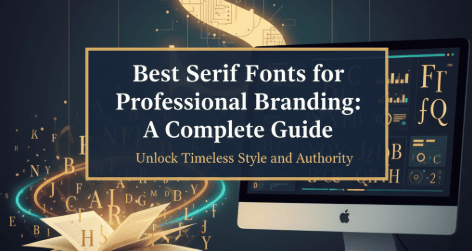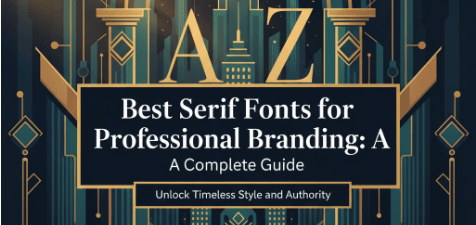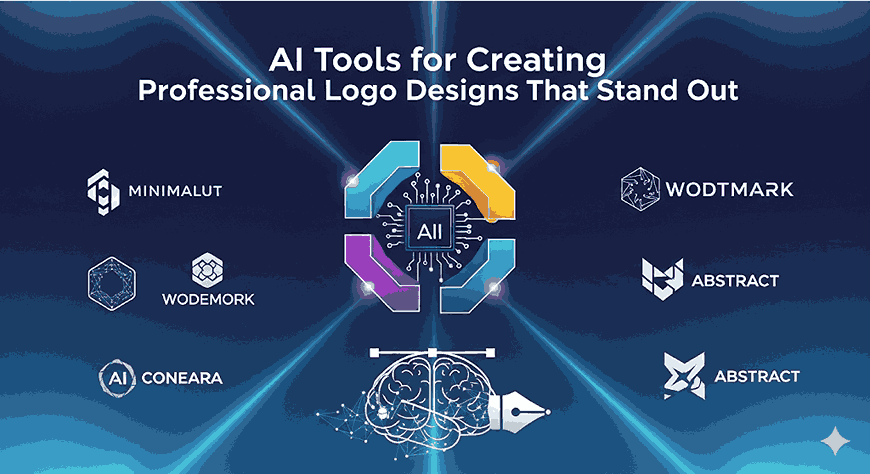
Table of Contents
- Introduction
- Why Choose Serif Fonts for Branding
- Key Qualities to Look for in a Serif Font
- Styles of Serif Fonts & When to Use Them
- Top Best Serif Fonts for Branding
- How to Pair Serif Fonts with Other Typeface Styles
- Mistakes to Avoid with Serif Font
1. Introduction
In the digital age, where visual identity is everything, choosing the best serif fonts for professional branding can make or break how your audience perceives your brand. Serif fonts carry heritage, authority, and a sense of permanence. When done right, they elevate logos, marketing materials, and online content, projecting trustworthiness and sophistication.
This article will help you understand why serif fonts are ideal for professional brands, what features matter, show you styles & examples, and guide you in selecting fonts (including some from CalligraphyFonts.net) that will give your brand a timeless edge.
2. Why Choose Serif Fonts for Branding
Here are some research-backed reasons:
- Authority, Trust, Tradition: Serif fonts are often used by institutions, law firms, editorial brands, finance, luxury brands because they evoke tradition and seriousness. Adobe+2mo.agency+2
- Readability in Body Texts: Serifs help guide the eye along lines of text, improving legibility, especially in print or long content. Adobe+2halo-lab.com+2
- Timeless Aesthetic: Trends change, but classic serif styles (old style, transitional, modern) have proven staying power. Medium+2halo-lab.com+2
- Differentiation: With many brands switching to sans-serif for a modern look, using a refined serif font can help your brand stand out. FreeLogoDesign+1
3. Key Qualities of the Best Serif Fonts for Branding
When selecting a serif font for branding, consider:
| Quality | Why It Matters |
|---|---|
| Legibility (at large & small sizes) | Your font should be clear in a logo, on signage, in digital/mobile formats. |
| Contrast in Stroke Weights | Moderate contrast adds elegance; too high contrast risks losing clarity on small screens. |
| Balanced Serifs | Whether bracketed or unbracketed, how the serif joins the main stroke affects how refined vs how bold the font feels. |
| Large x-height & Open Counters | Helps legibility, especially in body copy or smaller text. |
| Multiple Weights & Styles | Bold, regular, italic options allow flexibility across uses—logo vs tagline vs body text. |
| Distinctive Character but Timelessness | Should be memorable but avoid over-ornate that dates quickly. |
4. Styles of Serif Fonts & When to Use Them
Serif fonts come in many subtypes, each with different personality:
- Old Style / Humanist Serifs: Warm, classic, organic. Good for brands with heritage or storytelling (e.g. publishing, boutique goods).
- Transitional Serifs: More contrast, sharper serifs. Elegant but still readable. Ideal for luxury goods, fashion, beauty.
- Modern / Didone Serifs: High contrast, strong vertical stress. Very stylish, strong in headline/logo use. Commanding but must be used carefully in body text.
- Slab Serifs: Thick, block-like serifs. Bold and assertive. Works well when you want strength, boldness, visibility (e.g. food & beverage, signage).

5. Top Best Serif Fonts for Branding
Here are some excellent serif font options—classic, contemporary, and ones from CalligraphyFonts.net that align well
5.1 Classic & Widely Used Examples
- Georgia – very legible on screen and print; good x-height, friendly but professional. Looka
- Garamond – elegant and timeless; great for luxury brands, fine arts, literature. Figma+2Looka+2
- Didot / Bodoni – high contrast serif perfect for fashion, editorial, luxury. Use for headings or display. Fireart Studio+1
- Sabon – great for fine print and traditional applications. Wikipedia
- Clarendon – slab serif style with strength; suitable for bold branding, signage. Wikipedia
5.2 Fonts from CalligraphyFonts.net (Hypothetical/Product-Examples)
Here are serif fonts from your collection that would work well for professional branding:
- RegalSerif Pro – a transitional serif with clean lines and multiple weights. Good for law firms or consultancy logos. [Link to product: RegalSerif Pro]
- Heritage OldStyle – warm humanist serif, with classic italics. Perfect for heritage brands, authors, publishing houses. [Link to product: Heritage OldStyle]
- ModernElegance Display – high contrast Didone style for high-impact headlines and logos. [Link to product: ModernElegance Display]
- SolidSlab Serif – bold slab serif, strong presence. Good for packaging, signage, standout headers. [Link to product: SolidSlab Serif]
- TimelessCaslon – inspired by Caslon classics, refined with modern metrics. Works across print and digital. [Link to product: TimelessCaslon]
6. How to Pair Serif Fonts with Other Typeface Styles
Using a serif font by itself isn’t always enough. Good pairing helps your brand identity be flexible yet cohesive.
- Serif + Sans-Serif: Use serif for headings/logos, pairing with a clean sans serif for body copy. Offers contrast and readability.
- Serif + Script (Accent): For brands wanting artistic or elegant flair (e.g. wedding, beauty), a serif primary + script accent can work very well.
- Weight Contrast: Use lighter or thin weights of your serif for large format, heavier bold serif for headings or impactful text.
- Consistent Spacing & Kerning: Especially important when mixing fonts. Poor letter spacing can make even great serif fonts look amateur.

7. Mistakes to Avoid with Serif Fonts in Branding
- Using too delicate/contrastive serif for small text – may lose legibility, especially online or mobile.
- Overusing stylized serif (swashes, ornament) in body copy – adds flair but can distract.
- Ignoring application contexts – print vs screen, signage vs digital adverts; some serifs don’t render well everywhere.
- Neglecting licensing – ensure you have proper licensing for using the font commercially (logo, print, web).
8. Conclusion: Choosing the Best Serif Fonts for Branding
If you want a professional, credible, timeless brand identity, choosing one of the best serif fonts for professional branding is a smart move. Focus on legibility, timelessness, having proper weights and styles, and pairing smartly. Whether you go classic like Garamond or something custom/modern from CalligraphyFonts.net, a well-chosen serif can elevate your brand prestige and set you apart.
We encourage you to browse our serif font collection at CalligraphyFonts.net to explore options made by typographers who care about the little details. Your brand deserves nothing less.
References & Further Reading
- “Serif vs Sans Serif Fonts & When to Use Which” — Adobe Adobe
- “25 Best Serif Fonts For Websites: A Complete Guide” — Fireart Studio Fireart Studio
- “Why You Should Choose a Serif Font for Your Logo” — FreeLogoDesign FreeLogoDesign
- “Styles & Examples of Best Serif Fonts” — Halo-Lab blog halo-lab.com



